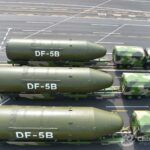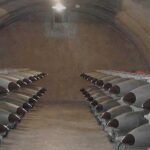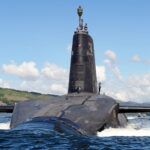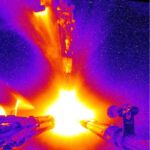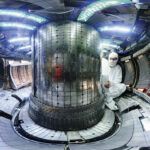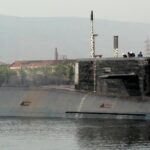1946: Can air or water be exploded?
By Hans Bethe | December 7, 2020
1946: Can air or water be exploded?
By Hans Bethe | December 7, 2020
Editor’s note: This article was originally published in the March 15, 1946 issue of the Bulletin. It is republished here as part of our special issue commemorating the 75th year of the Bulletin.
There has been much public discussion as to whether or not atomic bombs can start a nuclear chain reaction in the atmosphere. Similarly, since the planning of the Navy tests, many thoughtful scientists have expressed concern about the possibility of the chain reaction in water. And at least one fiction story appeared which told in an impressive way of the end of the earth caused by a chain reaction throughout the solid matter of the earth.
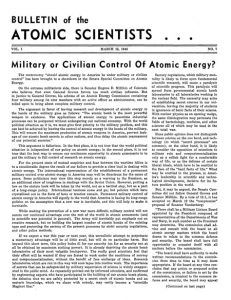 This concern is, of course, very well taken, and it is necessary to examine in great detail the possible dangers of atomic bomb tests before carrying them out. Such considerations can be made with the help of existing nuclear theory without making any assumptions going beyond the range of well explored phenomena. The conclusion from the calculations is that there is no danger of a nuclear explosion in any substance naturally occurring on earth with any of the atomic bombs which have been developed or have been conceived on paper.
This concern is, of course, very well taken, and it is necessary to examine in great detail the possible dangers of atomic bomb tests before carrying them out. Such considerations can be made with the help of existing nuclear theory without making any assumptions going beyond the range of well explored phenomena. The conclusion from the calculations is that there is no danger of a nuclear explosion in any substance naturally occurring on earth with any of the atomic bombs which have been developed or have been conceived on paper.
The most effective safeguard against unwanted nuclear chain reactions is the fact that all atomic bombs must carry a considerable amount of inert material, including the firing mechanism, the neutron reflector, and other parts which have a total weight many times greater than that of the active material. For this reason, the temperatures which can be transmitted to the material surrounding the bomb are very much lower than the temperatures existing inside the active material. It is well known that all nuclear reactions depend very strongly upon temperature, i.e., on the energy with which the various nuclei are moving against each other. A lowering of the temperature, therefore, means a great reduction of the probability of nuclear reactions.
The Bomb and the stars
The temperatures which can be produced in the air or water surrounding an atomic bomb of present construction are of the order of 1,000,000 degrees, maybe somewhat more, maybe somewhat less. This is very much lower than the temperatures prevailing at the center of ordinary stars, which are of the order of 20,000,000 degrees. We can, therefore, use the stars for comparison and can be sure that the nuclear reactions in the substance surrounding the atomic bomb will be less frequent than in the stars. Moreover, it is clear that the amount of inert material in the bombs could be reduced appreciably before we would attain in the surrounding material the conditions which prevail in the stars.
In normal stars the most important nuclear reactions are believed to be between protons on one side and carbon or nitrogen nuclei on the other. The reaction between protons and oxygen is less probable by a factor of about 10,000 at stellar temperatures, but even the reaction between protons and carbon is extremely slow, so that it would take several million years for the carbon in the sun to be consumed (if it were not regenerated in the actual stellar reaction cycle). A nuclear reaction which takes millions of years to be completed is certainly very far from being an explosion, at least by a factor 1014. It will also be noted that neither in water nor in air are there large numbers of those nuclei which would cause one of the probable reactions, i.e., carbon and hydrogen, or nitrogen and hydrogen.
Another reaction the theory of which has been developed in detail, is the combination of two protons to form a deuteron with the emission of a positron during the collision. This reaction is simple enough to be treated with some completeness by present theory. It is favored by the fact that the two interacting nuclei have the smallest possible charge and have also a small mass (which facilitates leakage through the potential barrier according to the Gamow theory). On the other hand, the proton-proton reaction is made improbable by the fact that a positron must be emitted during the process in order to conserve the charge. It is well known that all processes involving the emission of negative or positive electrons are exceedingly improbable as measured by nuclear standards. The calculation of the rate of this process shows that in normal stars it is slightly less probable than the reaction between protons and carbon or nitrogen. However, since it involves a relatively small potential barrier, this reaction will fall off less rapidly than others when the temperature is decreased. It is, therefore, presumably the most likely reaction around 1,000,000 degrees. But even at 20,000,000 degrees, its rate would only be sufficient to consume all hydrogen in a star during the course of several billions of years, which is removed from an explosive reaction by at least a factor of 1017. At 1,000,000 degrees, the reaction must be considerably slower than this.
The fission of water and air
Many scientists have asked me in recent letters why it is possible for the stars to have a sustained nuclear reaction if it is not possible for the water or the air to become ignited by an atomic bomb.
The difference between the two situations is that in the sun the temperature is kept high because it is difficult for the sun’s radiation to escape. The temperature in the sun changes very gradually from the 20,000,000 degrees in the center, to the 6,000 degrees at the surface. There is nowhere a strong temperature gradient and therefore the transport of radiation is very slow. If we explode an atomic bomb under water, and even if we were to succeed in heating the water to the same temperature as the center of the sun, this high temperature would only be attained in a very small volume. Radiation would carry the energy away very rapidly to the surrounding water. This means that in order to get a self-sustaining reaction one of two things must be done: First, the energy developed by the nuclear reaction must be so great that it overcompensates the loss of heat due to radiation. Even the most probable nuclear reactions discussed above fail to do this by a factor of at least 1,026 at 20,000,000 degrees, and by a much greater factor at 1,ooo,ooo degrees. The second possibility is to heat a very large volume of water simultaneously to a very high temperature, but this clearly requires enormous amounts of active material in the atomic bomb, exceeding by many powers of 10 the sizes of bombs ever contemplated.
The examination of possible nuclear reactions has to take into account also other possibilities, involving rarer elements, such as the reaction between two deuterium nuclei. This reaction is the most probable known nuclear reaction at low temperatures. However, even pure deuterium would fall far short of sustaining a chain reaction at 20,000,000 degrees, and the very small amount of deuterium in water will be of no consequence whatever in this connection.
Accuracy of the conclusions
It is often argued that considerations of the type here given involve a considerable extrapolation of present knowledge. It is my personal opinion that this is not the case. The energies of the nuclear particles involved are very small—below the energies normally used in the laboratory. While we should be very cautious in extrapolating our present knowledge of nuclear physics to higher energies, where new phenomena will certainly come in, we have very good means of extrapolating to lower energies. Such an extrapolation involves only the use of standard quantum mechanics as embodied in the Gamow theory. This theory has always been confirmed by experimental investigations of the cross sections of reactions between light nuclei at low energies. In some cases, like the reaction between two deuterons, direct experimental investigations have been carried to very low energies. The greatest danger in making theoretical estimates at low energies seems to be the possibility of some resonance in this region. However, the calculations can easily be done, taking into account a resonance of the greatest possible strength, and even then the result is many powers of 10 below the possibility of a chain reaction.
Moreover, we have the experience of the stars to go by. All the elements abundant in water or in the atmosphere are also abundant in stars. If their nuclei were capable of reacting with high probability at any temperature up to 20,000,0000 degrees, this reaction would certainly occur in the stars and would consume the elements in question or greatly increase the energy production. This argument has the weakness that our concept of the exact temperature distribution in the stars is itself based on theoretical considerations. The astrophysical argument, therefore, should only be regarded as supplementary evidence, supporting the theoretical calculations based on quantum mechanics.
It appears, then, that atomic bombs of present construction are safe by enormous margins against igniting either the atmosphere or the water or the earth. There are good reasons to believe that even any conceivable future improvements of the bombs will still be safe in this respect. However, before any test of such an improved bomb, a detailed consideration, taking into account the particular features of the future bomb, will be absolutely essential.
It seems to me that the objection to the Navy test does not lie in the possibility of setting the ocean on fire. The objections which we, as scientists, have are concerned with the problematical significance of the first two tests as planned. This criticism has been thoroughly discussed in this Bulletin in the issue of February 15. We now hear with especially great concern that there are some discussions of abandoning the third test of the bomb, the one under water, which is the only test which can be regarded as significant. If this were done, it would be far better to abandon also the first two tests which will only serve to mislead the public as to the effects of the atomic bomb on ships.
More important still, let us not forget that over and above the Navy tests and the problem of igniting the ocean, there is one problem which is of really overwhelming concern to us all: the problem of international control of the bomb. While some scientists may argue that there might be a remote chance of our concepts of theoretical physics being false at some point which might invalidate our predictions, they will all agree that there is an immeasurably greater danger that the peoples of the world will not have sufficient wisdom to settle their differences before a war breaks out which will be fought with atomic weapons. To draw everybody’s attention to this possible catastrophe has been, and still is, the main concern of all of us.
Together, we make the world safer.
The Bulletin elevates expert voices above the noise. But as an independent nonprofit organization, our operations depend on the support of readers like you. Help us continue to deliver quality journalism that holds leaders accountable. Your support of our work at any level is important. In return, we promise our coverage will be understandable, influential, vigilant, solution-oriented, and fair-minded. Together we can make a difference.
Keywords: archive75, chain reaction, fission of air, fission of water
Topics: Nuclear Weapons








